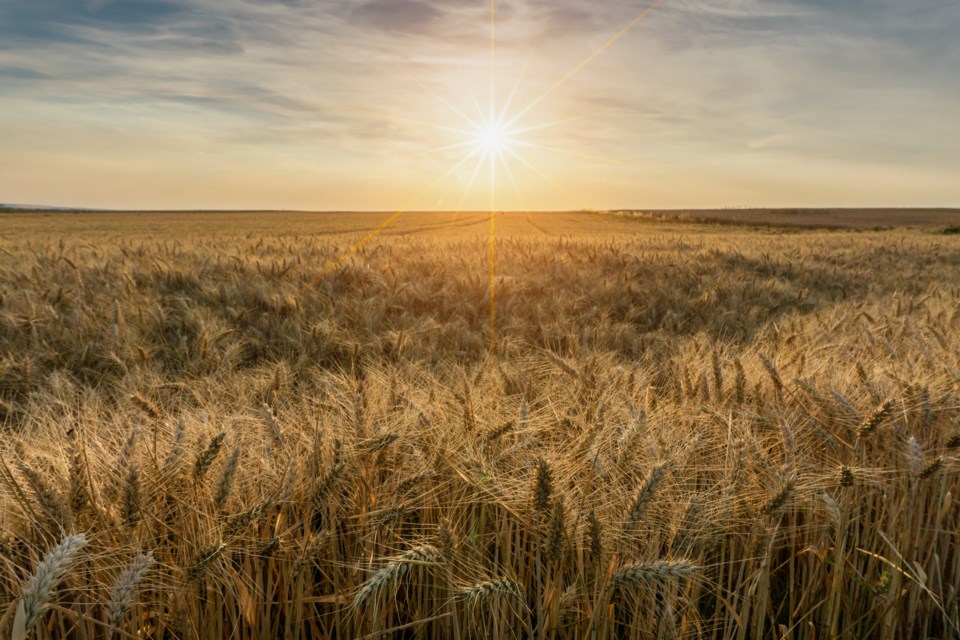WEYBURN -- As the hot, dry weather over the past week continues, crops are turning quicker than normal and have become ready for harvest. Producers have indicated that harvest will be general throughout the region within the next week.
Many producers would like more rain to recharge the water table and help with pasture growth; any rain now is too late to affect crop yield.
Water in dugouts and other ground water sources is getting very low and quality is becoming more of an issue with livestock producers with many having to haul water to their cattle.
North Saskatchewan
Another week of no rain and high temperatures has crops rapidly maturing across the region with some producers able to begin harvesting much sooner than previous years. So far mostly winter cereals have been combined and some other cereal and pulse crops have been cut and baled for greenfeed. Crops throughout the region are showing signs of drought stress and their yields will reflect the quality of growing conditions.
Cropland topsoil moisture in northeastern Saskatchewan is rated as one per cent adequate, 29 per cent short and 70 per cent very short. Hay and pasture land topsoil moisture is rated as seven per cent adequate, 22 per cent short and 71 per cent very short. Pastures in the north region are struggling from the heat and season long drought. They are rated as 14 per cent fair, 43 per cent poor and 43 per cent very poor.
Cropland topsoil moisture in northwestern Saskatchewan is rated as three per cent adequate, 31 per cent short and 66 per cent very short. Hay and pasture land topsoil moisture is rated as four per cent adequate, 28 per cent short and 68 per cent very short. Pasture conditions are rated as two per cent good, 16 per cent fair, 28 per cent poor and 54 per cent very poor.
Central Saskatchewan
Extremely hot dry conditions in the central Saskatchewan region have left the crops short and rapidly matured allowing for harvest to begin sooner than normal.
Winter cereals are being combined and some are being cut for greenfeed along with many fields of oats. Field pea and lentils that were desiccated weeks ago are now ready to combine and producers will get into those fields soon as the heat continues to dry down everything very quickly.
Topsoil moisture conditions in east central Saskatchewan have continued to deteriorate in the region. Cropland topsoil moisture is rated as three per cent adequate, 37 per cent short and 60 per cent very short. Hay and pasture land topsoil moisture is rated as two per cent adequate, 33 per cent short and 65 per cent very short. Pasture conditions in east central Saskatchewan are rated as 13 per cent fair, 41 per cent poor and 46 per cent very poor.
Cropland topsoil moisture in west central Saskatchewan is rated as one per cent adequate, 13 per cent short and 86 per cent very short. Hay and pasture land topsoil moisture is rated as one per cent adequate, 12 per cent short and 87 per cent very short. Pasture conditions in west central Saskatchewan are rated as 12 per cent fair, 21 per cent poor and 67 per cent very poor.
Â鶹ÊÓƵ Saskatchewan
Producers in southeastern and southwestern Saskatchewan have started harvesting winter cereals and pulse crops. There have been several reports that some producers have cut written off crop fields for greenfeed to use for their farms or help out their livestock-producing neighbours. Many producers have also voiced concern around the high risk of combine fires and are ensuring they have the necessary supplies and equipment to combat potential fires.
Cropland topsoil moisture in the southeast is rated as five per cent adequate, 57 per cent short and 38 per cent very short. Cropland topsoil moisture in the southwest is rated as two per cent adequate, 20 per cent short and 78 per cent very short.
Hay and pasture land topsoil moisture in the southeast is rated as two per cent adequate, 34 per cent short and 64 per cent very short. Hay and pasture land topsoil moisture in the southwest is rated as 17 per cent short and 83 per cent very short.
Pasture conditions in the southeast are rated as four per cent good, 21 per cent fair, 47 per cent poor and 28 per cent very poor. Pasture conditions in the southwest Saskatchewan are rated as one per cent good, 25 per cent fair, 27 per cent poor and 47 per cent very poor.
The majority of crop damage this week was due to heat, drought stress, wind and gophers. There were reports of insects such as grasshoppers, which are still problematic in crops and pastures; some producers are spraying to keep the damage low but others are limited by their time commitment to harvest.




